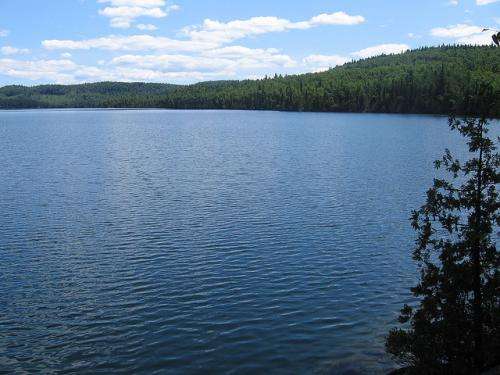Dr Schmieder examined core samples from Clearwater Lake (pictured) collected by the Canadian Geological Survey in the 1960s and 1970s.Image: Tim Schleicher
UWA geologists have helped debunk a long-held belief that twin asteroids formed Canada's Clearwater Lakes.
Geo-chronologist Martin Schmieder says one of the two circular structures in Quebec is almost 200 million years older than the other.
He says the western lake formed about 286 million years ago in the Permian era, while the eastern lake is about 460 – 470 million years old, putting it in the Ordovician era.
A continuous body of water, the lakes are partially separated by a band of islands less than 10km wide.
Dr Schmieder led an international team examining core samples collected by the Canadian Geological Survey in the 1960s and 1970s.
"At that time the prevalent theory was that these craters were like a doublet impact crater," he says.
"That was something that we wanted to check, especially as there was a 1990 publication that had suggested there was something wrong with those ages."
They used the argon-argon dating method, which measures potassium 40 levels.
"What we look for is melt rocks, that is rocks that were melted on impact," he says.
"These rocks usually experience temperatures in excess of 2,000 degrees which also reset that potassium argon clock."
The dating method involves bombarding small melt rock samples with neutrons in a nuclear reactor and then processing the samples in a modern mass spectrometer.
Age narrowed down to the ten thousand year level
"Using that mass spectrometer nowadays you can actually obtain ages with fairly good accuracy down to the hundred, or even ten thousand, year levels," Dr Schmieder says.
He says the results shows freaks of nature do occur.
"Even old theories can basically turn out inaccurate—that does not mean that we blame our results, our observations," he says.
Co-author Eric Tohver says the 50-year-old hypothesis had an understandable basis.
"The idea that a meteorite could hit very close to a previous meteorite has always been dismissed or considered to be so improbable as to be impossible," he says.
"It's the equivalent of lightning striking twice, say, in the same place except with something more extraordinary than a lightning strike, which happens hundreds of thousands of times a day."
Dr Schmeider is studying two more crater pairs suspected of being "false doublets".
One pair is in Finland, and the other a smaller crater within Canada's giant Sudbury Basin, which is the world's second-largest known meteorite crater.
Provided by Science Network WA
























